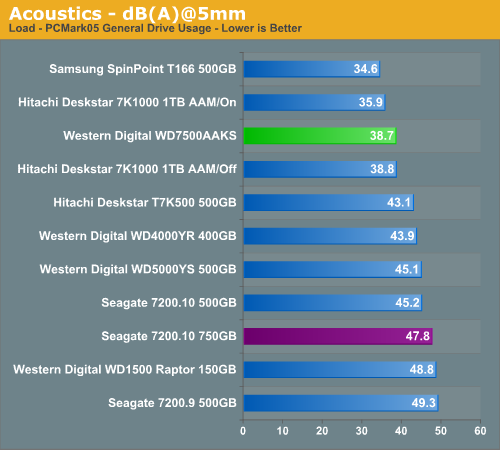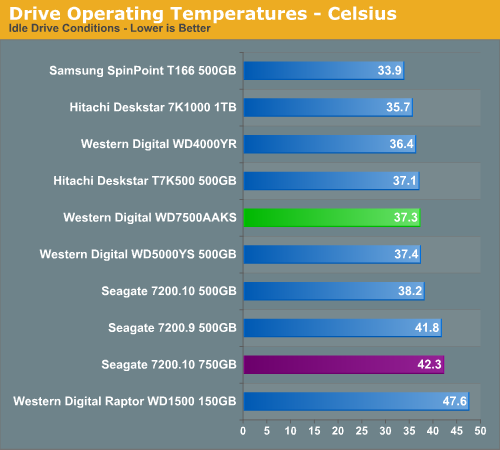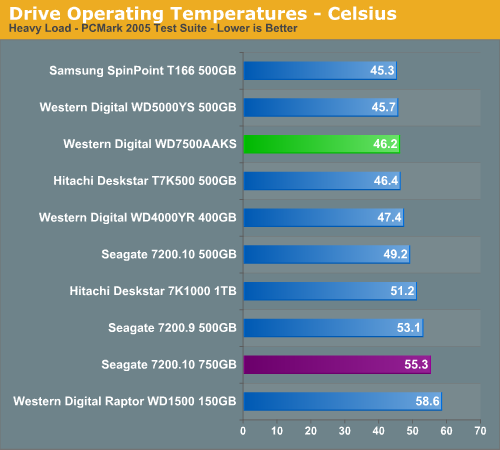Western Digital SE16 750GB: "Quiet" a Performer
by Dave Robinet on August 9, 2007 2:00 AM EST- Posted in
- Storage
Acoustics
Our acoustic test utilizes our standard test bed components but we implement Intel's power saving technology and turn off the case fans to eliminate as much case noise as possible during testing. Our Corsair power supply is nearly silent in these tests and our MSI 8800GTX video card is water cooled by an external pump/radiator unit to provide a further decrease in our case's ambient noise levels. Our drives are attached to the drive cage with rubber bushings to assist in isolating the noise of the drive and avoid the resulting harmonic changes due to the case design.
Our acoustic tests are designed to measure the decibel levels while the system is at idle and also under load while running the General Hard Disk Drive Usage benchmark within PCMark 2005. We found through trial and error that this particular benchmark produces controlled readings across a wide range of applications within the benchmark. This particular benchmark utilizes 60% reads and 40% writes within the trace playback file.
The measurements are taken at a distance of 5mm from the rear and front of the drive being tested in order to minimize surrounding environmental noise. We have noticed that unless we run a completely silent system in a quiet room that measurements taken from 1m are generally not meaningful because they are lost in the surrounding ambient noise. There are exceptions - like the Raptor series of drives - but overall most modern desktop drives are quieter now than the other components in the system.
The reported measurements are based on an A-weighted decibel score that measures frequencies similar to the way the human ear responds to sound. We take a total of three measurements for each test. We then subtract the high and low scores and arrive at our findings by reporting the remaining score. Our base dB(A) level in the room at time of testing was 25 dB(A).


Western Digital's claim of a quiet drive is indeed backed up by our acoustic measurements, though it cannot claim to be the quietest. Its idle noise measurement of just over 30dB(A) makes it a few decibels louder than both the Hitachi 7K1000 and the Samsung T166 drives which we've recently tested in the AnandTech labs. The score does represent nearly a 3 decibel reduction from any Western Digital drive we've previously tested, however, and easily bests the Seagate 750GB 7200.10.
The drive's activity measurements of 38.7dB(A) show the same pattern. The drive is still roughly 4 decibels louder than the whisper-quiet SpinPoint T166, but shows up substantially better than most other desktop drives in this class. The noise emitted by the drive during periods of activity can best be described as a low "thumping" or "pulsing" noise that was not obtrusive but noticeable at times.
Thermals
Our thermal tests utilize sensor readings via the S.M.A.R.T. (Self-Monitoring, Analysis and Reporting Technology) capability of the drives and are reported by utilizing the Active SMART 2.42 utility. We also utilize thermal sensors and infrared measurement devices to verify our results. We test our drives in an enclosed case environment without the fans operational to simulate temperatures that could conceivably be reached in a near silent SFF or HTPC case design. We typically find the reported numbers drop anywhere from 18% to 25% with the case fans operational. Our base temperature level in the room at the time of testing was 25C.


At 37.2C idle, the WD7500AAKS ends up in the middle of the pack. The situation improves dramatically, however, when the drive is under heavy load, coming in at an impressive 46.2C. This score is currently bested only by the Samsung T166 and the WD7500AAKS's smaller sibling, the 500GB WD5000YS. Keep in mind that larger drives with more platters usually generate more heat, so the temperature result is all the more impressive.
Our acoustic test utilizes our standard test bed components but we implement Intel's power saving technology and turn off the case fans to eliminate as much case noise as possible during testing. Our Corsair power supply is nearly silent in these tests and our MSI 8800GTX video card is water cooled by an external pump/radiator unit to provide a further decrease in our case's ambient noise levels. Our drives are attached to the drive cage with rubber bushings to assist in isolating the noise of the drive and avoid the resulting harmonic changes due to the case design.
Our acoustic tests are designed to measure the decibel levels while the system is at idle and also under load while running the General Hard Disk Drive Usage benchmark within PCMark 2005. We found through trial and error that this particular benchmark produces controlled readings across a wide range of applications within the benchmark. This particular benchmark utilizes 60% reads and 40% writes within the trace playback file.
The measurements are taken at a distance of 5mm from the rear and front of the drive being tested in order to minimize surrounding environmental noise. We have noticed that unless we run a completely silent system in a quiet room that measurements taken from 1m are generally not meaningful because they are lost in the surrounding ambient noise. There are exceptions - like the Raptor series of drives - but overall most modern desktop drives are quieter now than the other components in the system.
The reported measurements are based on an A-weighted decibel score that measures frequencies similar to the way the human ear responds to sound. We take a total of three measurements for each test. We then subtract the high and low scores and arrive at our findings by reporting the remaining score. Our base dB(A) level in the room at time of testing was 25 dB(A).


Western Digital's claim of a quiet drive is indeed backed up by our acoustic measurements, though it cannot claim to be the quietest. Its idle noise measurement of just over 30dB(A) makes it a few decibels louder than both the Hitachi 7K1000 and the Samsung T166 drives which we've recently tested in the AnandTech labs. The score does represent nearly a 3 decibel reduction from any Western Digital drive we've previously tested, however, and easily bests the Seagate 750GB 7200.10.
The drive's activity measurements of 38.7dB(A) show the same pattern. The drive is still roughly 4 decibels louder than the whisper-quiet SpinPoint T166, but shows up substantially better than most other desktop drives in this class. The noise emitted by the drive during periods of activity can best be described as a low "thumping" or "pulsing" noise that was not obtrusive but noticeable at times.
Thermals
Our thermal tests utilize sensor readings via the S.M.A.R.T. (Self-Monitoring, Analysis and Reporting Technology) capability of the drives and are reported by utilizing the Active SMART 2.42 utility. We also utilize thermal sensors and infrared measurement devices to verify our results. We test our drives in an enclosed case environment without the fans operational to simulate temperatures that could conceivably be reached in a near silent SFF or HTPC case design. We typically find the reported numbers drop anywhere from 18% to 25% with the case fans operational. Our base temperature level in the room at the time of testing was 25C.


At 37.2C idle, the WD7500AAKS ends up in the middle of the pack. The situation improves dramatically, however, when the drive is under heavy load, coming in at an impressive 46.2C. This score is currently bested only by the Samsung T166 and the WD7500AAKS's smaller sibling, the 500GB WD5000YS. Keep in mind that larger drives with more platters usually generate more heat, so the temperature result is all the more impressive.










37 Comments
View All Comments
Dave Robinet - Thursday, August 9, 2007 - link
Actually, the difference is that the EIDE drive only is offered up to a 500GB capacity. This precludes it from having the additional features given to the 750GB drive, as mentioned in the article.If you're only using the single drive under "normal" desktop usage, however, you're not terribly likely to see a big difference in performance between a 500GB SATA and 500GB EIDE, all things being equal.
Thanks for reading!
dave
semo - Thursday, August 9, 2007 - link
i understand the sata vs. pata arguments. it's just the new features and low power draw that interest me and since the model numbers look so similar i thought that they would share the same characteristics.Frumious1 - Thursday, August 9, 2007 - link
Besides the one using a slower, outdated interface? Probably not. Thankfully, the 750GB drive is NOT available in PATA format as far as I can tell. WD's EIDE offerings top out at 500GB on their website. Seriously, who buys a top-end hard drive in EIDE format these days? Hell I only have one IDE connection on my motherboard, and that's no longer in use!semo - Thursday, August 9, 2007 - link
the 750gb version may be a top end part but the 500gb is very reasonably priced. anyway, you can never convince me that a hard drive is "high end", whatever the cost. real world performance does not vary much and depends very much on usage patterns. now an ssd or a revolutionary redesign of hdd i can consider to be high end.Dave Robinet - Thursday, August 9, 2007 - link
Agreed - if you can use SATA, you will. Some people can't, however, and the EIDE interface isn't an incredible bottleneck to the system (like, for example, the move from ISA to PCI graphics cards was in adopting the new bus).You're right, though - there's no reason to intentionally buy EIDE anymore if you have SATA available in your system. :)
Thanks for reading!
dave
Basilisk - Thursday, August 9, 2007 - link
'Won't there be negligible P-ATA demand, with none from manuf's? So, 'probably no P-ATA version, or a hefty premium on it.If my Linux distro supported the S-ATA controller chip, I'd spend the $20-$25 on a PCI or PCI-e S-ATA card and ignore the P-ATA. It would be a shame to have that P-ATA 750GB and later find yourself w/o a m/b having P_ATA to make good use of it! [Okay, you could probably buy a P-ATA controller card....]
wilburpan - Thursday, August 9, 2007 - link
Who buys a large capacity EIDE hard drive? I did recently.Why? I have an old computer that I've repurposed into a file server running Linux. This computer is old enough that it doesn't have SATA connections.